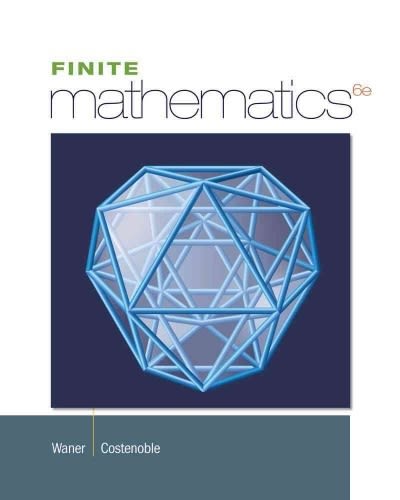Question
Tharun being poor at shooting goes after an objective and has likelihood 0.2 of hitting the objective with each shot, autonomously of any remaining shots.
Tharun being poor at shooting goes after an objective and has likelihood 0.2
of hitting the objective with each shot, autonomously of any remaining shots. Leave X alone the
number of hits.
1. Ascertain the PMF of X.
2. Discover the assumption and the change of X.
3. Assume Tharun needs to pay $3 to enter the shooting reach and he gets $2 dollars
for each hit. Leave Y alone his benefit. Discover the assumption and the change of Y .
4. Presently we should expect that Tharun enters the shooting range for nothing and gets the
number of dollars that is equivalent to the square of the quantity of hits. Leave Z alone his
benefit. Discover the assumption for Z.
A Gallup Daily Tracking Survey tracked down that the mean day by day optional spending by Americans procuring more than $90,000 each year was $136 each day (USA Today, July 30, 2012). The optional spending prohibited home buys, vehicle buys, and standard month to month bills. Let x = the optional spending each day and expect that a uniform likelihood thickness work applies with f (x) = 0.00625 for a x b.
a. Discover the estimations of an and b for the likelihood thickness work.
(16)
b. What is the likelihood that shoppers in this gathering have every day optional spending somewhere in the range of $100 and $200?
c. What is the likelihood that customers in this gathering have day by day optional expenditure of $150 or more?
d. What is the likelihood that customers in this gathering have day by day optional expenditure of $80 or less?
Auto fix costs keep on ascending with the normal expense now at $367 per fix (U.S. News and World Report site, January 5, 2015). Expect that the expense for an auto fix is regularly dispersed with a standard deviation of $88. Answer the accompanying inquiries regarding the expense of auto fixes.
a. What is the likelihood that the expense will be more than $450?
b. What is the likelihood that the expense will be under $250?
c. What is the likelihood that the expense will be somewhere in the range of $250 and $450?
d. On the off chance that the expense for your vehicle fix is in the lower 5% of car fix charges, what is your expense?
During the Covid diseas 2019 (COVID 19) emergency, there has been a public objection for mass screening of the populace in desires to control an effectively unfurling occasion. To this date, there is one test that has aided the current emergency, continuous opposite transcriptase polymerase chain response (rPT-PCR). Albeit getting all the more promptly accessible, there are inadequacies to the test when put in true situtations. The likelihood that the rRT-PCR effectively distinguishes somebody with COVID as certain is 0.87, and the likelihood that the test erroneously recognizes somebody without COVID as sure is 0.01. The frequency of the COVID in everybody is 0.001. You step through the examination and the outcome is positive. Allow P to indicate the occasion that you have COVID. Allow R to indicate the occasion that the rRT-PCR result is positive. a) What is the same numerical documentation for 0.87? b) What is the same numerical documentation for 0.017? c) What is the same numerical documentation for 0.001? d) What is the estimation of P(R)? e) What is the probabilty that you have COVID?
Step by Step Solution
There are 3 Steps involved in it
Step: 1

Get Instant Access to Expert-Tailored Solutions
See step-by-step solutions with expert insights and AI powered tools for academic success
Step: 2

Step: 3

Ace Your Homework with AI
Get the answers you need in no time with our AI-driven, step-by-step assistance
Get Started


